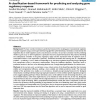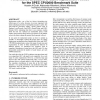194 search results - page 35 / 39 » Computing Roundness is Easy if the Set is Almost Round |
BMCBI
2006
13 years 7 months ago
2006
Background: We have recently introduced a predictive framework for studying gene transcriptional regulation in simpler organisms using a novel supervised learning algorithm called...
AAAI
2012
11 years 10 months ago
2012
The complexity of the winner determination problem has been studied for almost all common voting rules. A notable exception, possibly caused by some confusion regarding its exact ...
ACMSE
2004
ACM
14 years 28 days ago
2004
ACM
Replacement policy, one of the key factors determining the effectiveness of a cache, becomes even more important with latest technological trends toward highly associative caches....
PPOPP
2009
ACM
14 years 8 months ago
2009
ACM
Fairness is an essential requirement of any operating system scheduler. Unfortunately, existing fair scheduling algorithms are either inaccurate or inefficient and non-scalable fo...
FOCS
2009
IEEE
14 years 2 months ago
2009
IEEE
In the classical balls-and-bins paradigm, where n balls are placed independently and uniformly in n bins, typically the number of bins with at least two balls in them is Θ(n) and ...


